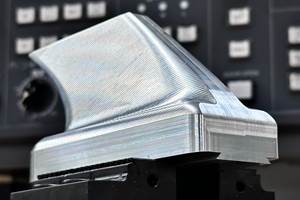10 Reasons Why Machine Shops Vary So Much in Quoted Pricing
Many factors explain the potential 10X variation in different shops’ bids for the same machining work.
Share





I recently assisted in a project conducted by , the research group within Modern Machine Shop publisher Gardner Business Media, which involved analyzing the machining costs of various part types. I asked several shops to provide quotes on certain parts, and thus encountered the predicament that buyers of machined parts routinely see: a wide range of prices. There is no simple answer to the question, “How much does it cost to machine this part?”
MakeTime has seen the same thing. This company, which is in the business of matching shops with customers, cites research finding a factor-of-10 discrepancy in quoted prices for identical machining work. Aiming to simplify costing, the company recently introduced a “network pricing” feature that can estimate a part’s machining cost based on MakeTime’s history and analysis of the costing of similar parts.
I recently asked MakeTime Director of Fulfillment Justin Hosley about the pricing discrepancy. Having previously worked in business development for a machine shop, he holds the view that there is no single explanation, but instead a variety of factors. His list is below, followed by a few additions of mine. Why do shops’ prices differ widely? Here are some reasons:
1. Capabilities. Many shops could make the part to print, but not all would employ equally sophisticated resources. The difference between five-axis machining and many setups on a simple mill affects price. So does the presence of in-house grinding rather than outsourcing this work.
2. Regionality. The presence of certain industries in a region bids up the local price. A shop in a rural area might comfortably quote a lower price than a shop in an area full of aerospace suppliers.
3. Capacity. Busy shops bid higher. (Since MakeTime’s pricing model is based on current open capacity, it sees this variation every day.)
4. Interpretation. Two shops can interpret the same job differently. The one that knows the customer well might know that some details of the print do not matter. The new supplier does not know what to ignore.
5. Automation. On higher-volume jobs, differences in labor cost affect pricing substantially.
6. Process. The experienced or clever engineer or machinist might see a more efficient way to set up or run the job than other bidders.
7. Relationships. Mr. Hosley has experienced this one. The 60-year-old shop he worked for could get better pricing on material than other, newer shops.
That is his list. I will add three more of my own:
8. Envelope. A given shop frequently is best adapted to run parts within a given size range, whether large or small. Competitively running parts outside this scale is difficult.
9. Qualification. If a shop has the assets qualifying it for a specific industry—think auditing staff, special machines or inspection capabilities—then it seeks to cover the cost of these assets even in work outside of that industry.
10. Error. Shops make mistakes in their quoting. Sometimes the reason behind a low bid is simply a shop that will be fortunate not to win that job.
Related Content
How to Evaluate Measurement Uncertainty
Manufacturing and measurement are closely coupled. An important consideration for the use of measurement results is the associated measurement uncertainty. This article describes common metrology terms and provides an example uncertainty analysis.
Read More4 Rules for Running a Successful Machine Shop
Take time to optimize your shop’s structure to effectively meet demand while causing the least amount of stress in the shop.
Read MoreCustom Workholding Principles to Live By
Workholding solutions can take on infinite forms and all would be correct to some degree. Follow these tips to help optimize custom workholding solutions.
Read MoreHow to Determine the Currently Active Work Offset Number
Determining the currently active work offset number is practical when the program zero point is changing between workpieces in a production run.
Read MoreRead Next
AMRs Are Moving Into Manufacturing: Considerations for Implementation
AMRs can provide a flexible, easy-to-use automation platform so long as manufacturers choose a suitable task and prepare their facilities.
Read MoreMachine Shop MBA
Making Chips and 91ÊÓƵÍøÕ¾ÎÛ are teaming up for a new podcast series called Machine Shop MBA—designed to help manufacturers measure their success against the industry’s best. Through the lens of the Top Shops benchmarking program, the series explores the KPIs that set high-performing shops apart, from machine utilization and first-pass yield to employee engagement and revenue per employee.
Read MoreLast Chance! 2025 Top Shops Benchmarking Survey Still Open Through April 30
Don’t miss out! 91ÊÓƵÍøÕ¾ÎÛ's Top Shops Benchmarking Survey is still open — but not for long. This is your last chance to a receive free, customized benchmarking report that includes actionable feedback across several shopfloor and business metrics.
Read More























